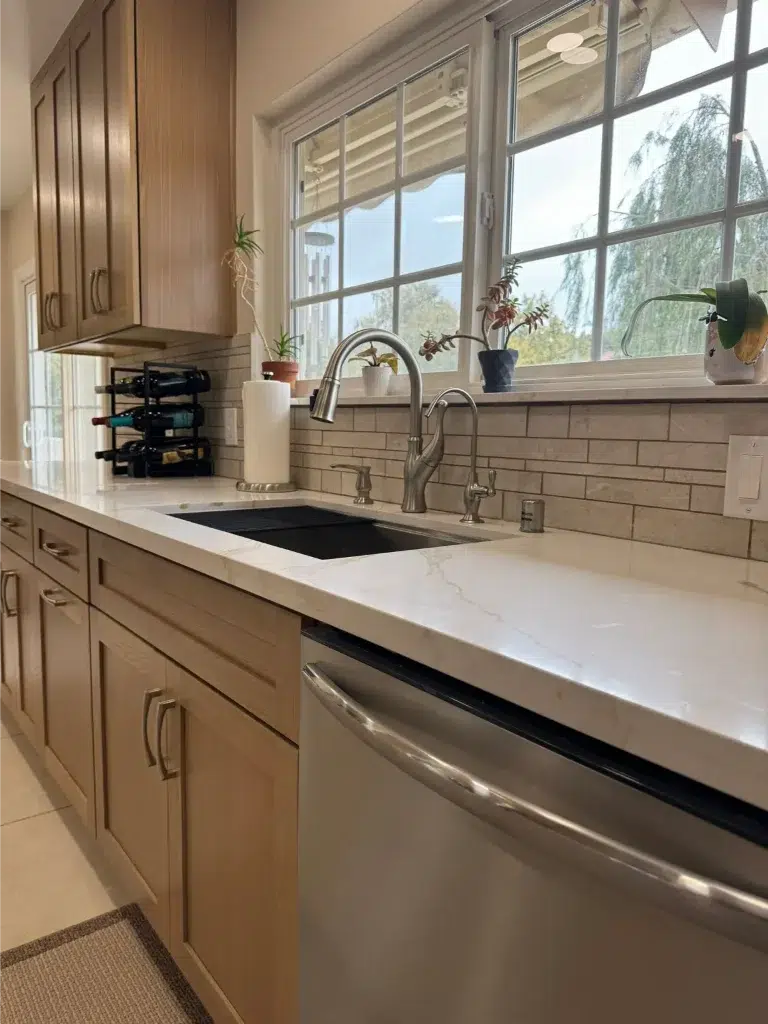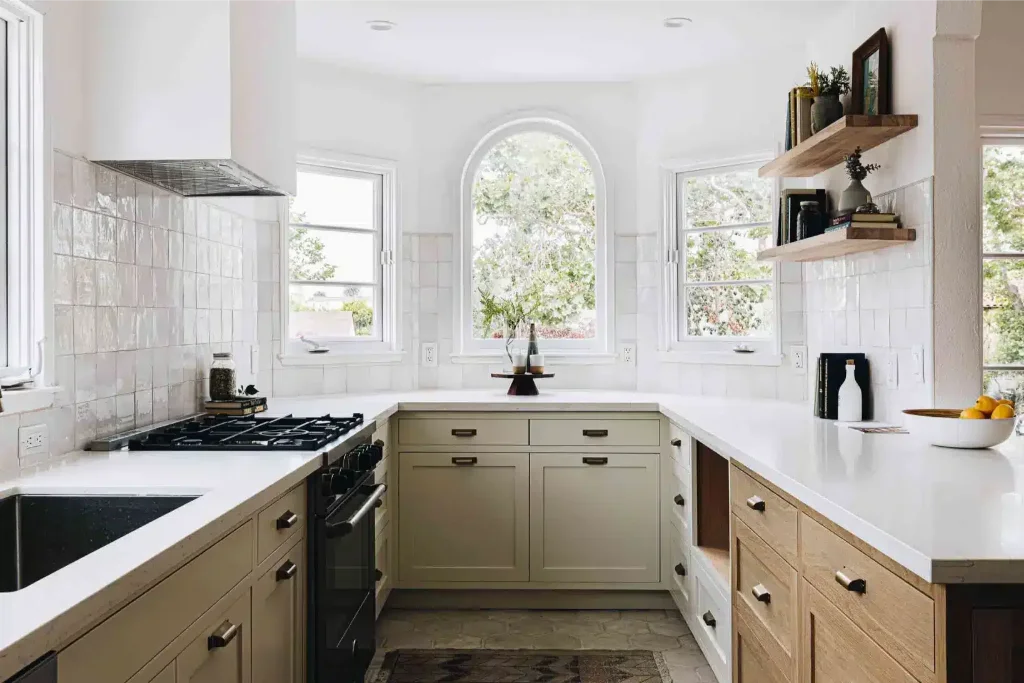Understanding Standard Kitchen Countertop Depth
When planning a kitchen renovation, knowing the typical measurements for work surfaces is essential. The standard countertop depth is typically 24 to 25 inches in most kitchens. This measurement works well for most households because it provides enough space for food prep without making it difficult to reach items at the back.
For kitchen islands, you might go with a deeper countertop usually 27 to 36 inches from front to back. Islands need this extra space since people often work from both sides. The beauty of these measurements is that they’ve been refined over decades to balance comfort and functionality in most kitchen layouts.
Factors Affecting Countertop Depth Decisions
Several things might influence your choice when selecting the ideal countertop depth for your kitchen surfaces:
- Available kitchen space and layout
- Your height and reach comfort
- Specific cooking habits and needs
- Appliance integration requirements
- Budget considerations
Your cooking style matters too! If you’re an avid baker who needs lots of rolling space, you might prefer wider surfaces in certain areas. Conversely, if your kitchen is compact, a standard or slightly smaller countertop depth might maximize your available space while maintaining functionality.
Cabinet and Countertop Depth Relationship

The dimensions of your cabinets directly impact your surface choices. Most standard base cabinets measure 24 inches from front to back, which pairs perfectly with the typical 25-inch countertop depth. This creates that slight overhang that prevents cabinet damage from spills.
Custom cabinets may have different dimensions, so you’ll need to adjust your planning accordingly. Some designers recommend a 1 to 1.5-inch overhang for optimal function and appearance, but this can vary based on your specific needs and kitchen design.
Types of Countertops and Their Ideal Depths
Different materials sometimes have different recommended countertop depths due to their structural properties and installation requirements.
Quartz Countertops: Depth Specifications and Benefits
Quartz surfaces typically follow the standard countertop depth of 24 to 25 inches, but their advantage lies in customization. Since quartz is engineered, it can be crafted to precise specifications for unique kitchen layouts. The material’s durability means it works well with various overhangs without requiring additional support for standard projections.
Manufacturers produce quartz slabs in standard dimensions, but custom fabrication allows for tailored sizing to match your specific kitchen design needs.

Natural Stone Options: Granite, Marble, and Quartzite
Natural stone materials generally follow similar countertop depth guidelines to quartz, but their natural properties can sometimes affect installation. For instance, granite’s strength might allow for slightly larger overhangs without support, typically up to 12 inches with proper reinforcement.
Marble, being somewhat more delicate, might require additional consideration for extended overhangs. The key with natural stones is working with experienced fabricators who understand the specific structural properties of your chosen slab.
Custom Countertops: Tailoring Depth for Your Dream Kitchen
The beauty of modern kitchen design lies in customization. While standard countertop depth works for most homes, your unique space might benefit from tailored solutions. Working with a skilled designer helps identify where adjustments might improve functionality.
Some homeowners opt for varied countertop depths throughout their kitchen, perhaps deeper surfaces near cooking areas and standard sizes elsewhere. This approach maximizes function where needed without wasting valuable kitchen space.
Choosing the Perfect Kitchen Countertop Depth: Final Considerations
The ideal countertop depth for your kitchen ultimately depends on how you use your space. Consider traffic flow, your height, cooking habits, and existing appliances when making your decision.
Remember that minor adjustments can make significant differences in comfort. An inch or two might not seem like much, but it can dramatically impact how comfortable your kitchen feels during daily use.
Take time to visit showrooms and test different configurations before making your final choice. The perfect kitchen balances standard guidelines with personalized adjustments that make the space truly yours.
Frequently Asked Questions About Countertop Depth
How much more do custom countertop depths cost compared to standard sizes?
Custom countertop depths typically cost 15-30% more than standard sizes. This price jump occurs because fabricators need to make special cuts, which can result in more material waste. Labor costs increase, too, since installation takes longer with custom measurements. Some materials, like quartz, might have less price difference than natural stone when customized. Always get multiple quotes to compare prices for your specific project.
Are there accessibility guidelines I should consider when choosing countertop depth?
ADA guidelines recommend a maximum countertop depth of 25 inches for wheelchair accessibility. Consider varied heights too, with some sections at 30 inches instead of the standard 36 inches. Shallower sections (20-22 inches) can help people with limited reach. Remember that front edge details matter for safety, and rounded edges prevent injuries for everyone, especially kids and seniors.
How does countertop depth affect my kitchen's resale value?
Standard countertop depth (24-25 inches) generally offers the best resale value since it appeals to most buyers. Significantly custom measurements might limit your buyer pool. However, thoughtfully designed islands with generous depth can actually boost appeal. The material choice usually impacts value more than the depth itself. Ultimately, a functional, attractive kitchen sells, regardless of exact measurements.
Can I change my countertop depth without replacing my cabinets?
Yes, but with limitations. You can increase depth by 1-3 inches without cabinet changes by extending the overhang, though supports may be needed for anything over 12 inches. Decreasing depth requires cutting existing surfaces or replacing them entirely. Cabinet modifications get expensive quickly, so minor depth adjustments work best. Consider a contractor consultation before deciding on significant changes.
What countertop depth works best for small kitchens?
For small kitchens, consider a slightly reduced countertop depth of 21-23 inches in some areas to improve traffic flow. Keep full depth (24-25 inches) in primary work zones, like near the sink or stove. Another trick is to vary the depth standard by the walls, but make it slimmer on peninsulas. This approach maximizes functionality without making the space feel cramped.
Are there special considerations for countertop depth around sinks and appliances?
Absolutely! Sink areas benefit from extra depth (minimum 25 inches) to accommodate modern farmhouse or undermount styles. Around cooktops, maintain standard or slightly deeper measurements for safety. Refrigerator areas can use standard depth, but dishwasher locations need precise matching to prevent awkward overlaps. Always check appliance specifications before finalizing your countertop depth plans.
